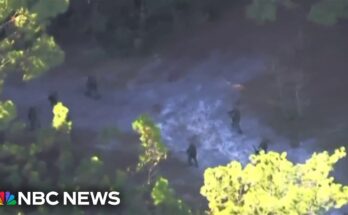On a routine day in Los Angeles, law-enforcement officers with the Los Angeles Police Department (LAPD) found themselves involved in a high-stakes pursuit when a vehicle reported stolen attempted to flee, igniting a chase that would culminate in rapid tactical decisions, split-second judgments, and the exertion of public-safety protocols under real-world pressure. The video titled “LAPD Chase Stolen Vehicle Suspect” captures a raw and dynamic moment — a stolen vehicle suspect, the responding units, and a scenario that plays out in tight seconds, challenging the officers’ training and the mechanical limits of vehicles involved.
From the moment the pursuit begins, the tension is immediately palpable. A stolen vehicle—perhaps obtained by force or otherwise illicitly—has already placed innocent citizens at risk simply by existing on the road unaccountably. The LAPD officers receive the call, identify the suspect vehicle, and begin their engagement. Their objective: apprehend the suspect, secure the vehicle, and ensure that no one else is harmed in the process. The video shows the suspect attempting evasive maneuvers, perhaps weaving through traffic, accelerating away, trying to out-pace law enforcement. For the officers, every second matters: they must decide when to speed, when to keep safe distance, how to coordinate backup, and how to ensure public safety—as reckless driving by the suspect may lead to collisions, injuries, or worse.
Vehicles are an inherently volatile element in such incidents, because they combine power, speed, unpredictability, and the presence of other road users. When someone in a stolen car refuses to stop, the risk amplifies. The officers must balance the urgency of stopping the suspect against the greater danger of a high-speed chase in urban environs. The video demonstrates how protocols come into play: marking units, using lights and sirens, coordinating via dispatch, and judging whether to persist or attempt specialised manoeuvres such as tactical stopping (PIT – precision immobilisation technique) or using spike strips. The suspect’s erratic driving, perhaps swerving, braking, accelerating, or even colliding with objects, underscores the importance of maintaining control and situational awareness.

In the footage, you’ll notice the officers adeptly navigating through city streets, responding to the suspect’s path, radioing updates: “Suspect heading eastbound on …,” “Requesting extra units,” “Spike strips deployed,” and so forth. Each communication reflects the layered strategy: containment, backup, minimisation of risk to bystanders, and the eventual termination of the chase. The suspect, meanwhile, finds options narrowing. Urban infrastructures—intersections, traffic lights, congestion—work against high-speed flight. The officers exploit that. Traffic patterns, civilian vehicles, and fixed objects become part of the operational environment. The suspect might attempt to use these to escape, but also faces the heightened risk of losing control or crashing.
Eventually the chase reaches a decisive moment. Whether by successful immobilisation, a crash, or the suspect surrendering, the video displays the endpoint of the pursuit. The suspect vehicle slows, officers pull in, suspect exits (often hands up), gets handcuffed, and officers secure the scene. The transition from frantic motion to a controlled arrest is abrupt—yet in that moment the accumulated training, teamwork, and protocol bear fruit. The stolen vehicle is recovered, the suspect is in custody, and the potential threat to the public is neutralised. The surrounding traffic begins to clear, the adrenaline of the chase gives way to procedural processing: evidence gathering, suspect interview, vehicle inventory, and tactical debrief.
Beyond the sheer heart-pounding visual of a chase, this video invites reflection on multiple layers of law enforcement, public safety, and vehicle-theft crime dynamics. First, vehicle theft remains a significant issue; stolen vehicles often are used in further crimes—getaway cars, transporting contraband, or tools in other felonies. The LAPD’s quick response and pursuit reflect how crucial timing is in preventing escalation. Second, decisions in a chase aren’t just about speed but about risk management: when to chase, when to call off, how to protect bystanders. The video highlights that even with sirens and lights, the environment remains unpredictable. Third, it offers a view into training and coordination: officers don’t simply chase—they communicate, strategise, and leverage backup and city infrastructure to control the situation safely.
For viewers, such videos also emphasise the importance of civilian behaviour during police pursuits. Traffic should clear when alerted, avoid interfering, and stay safe. Bystanders often play no active role in the event, but their presence affects how the chase can be managed. Safe distance, no reckless manoeuvres, and awareness can help ensure that law-enforcement efforts don’t inadvertently endanger innocents. The footage serves both as gripping action and educational insight.
In a broader sense, the chase underscores the evolving nature of police work in metropolitan areas like Los Angeles. Modern law-enforcement relies not just on sheer force or speed but on data, communications, and cooperative strategies. Real-time coordination via dispatch, GPS tracking, multiple units, and pre-planned escalation procedures all feed into successful outcomes. The video implicitly reflects these layers—though most visible is the dramatic vehicle pursuit.
Finally, this video is a reminder of how a single decision—to flee in a stolen vehicle, for instance—sets off a cascade of consequences. For the suspect, a moment of theft may lead to minutes of peril; for the officers, hours of work; for bystanders and the city, moments of potential hazard. And yet, thanks to training, preparedness, and decisive action, the situation ends with the vehicle recovered and community risk reduced. Watching “LAPD Chase Stolen Vehicle Suspect” thus offers more than adrenaline—it offers a window into the orchestration of public-safety response, the tactical dance of pursuit, and the stakes involved when a stolen car hits the streets.


